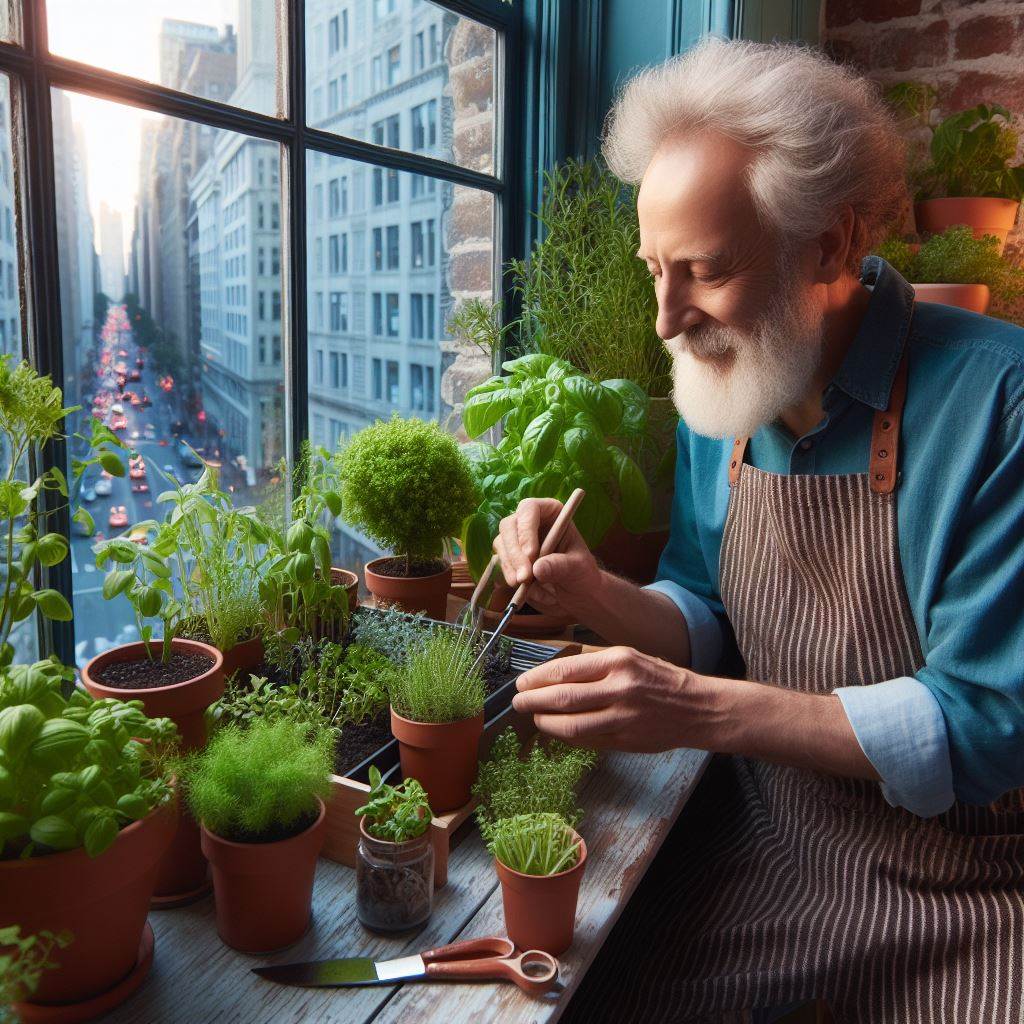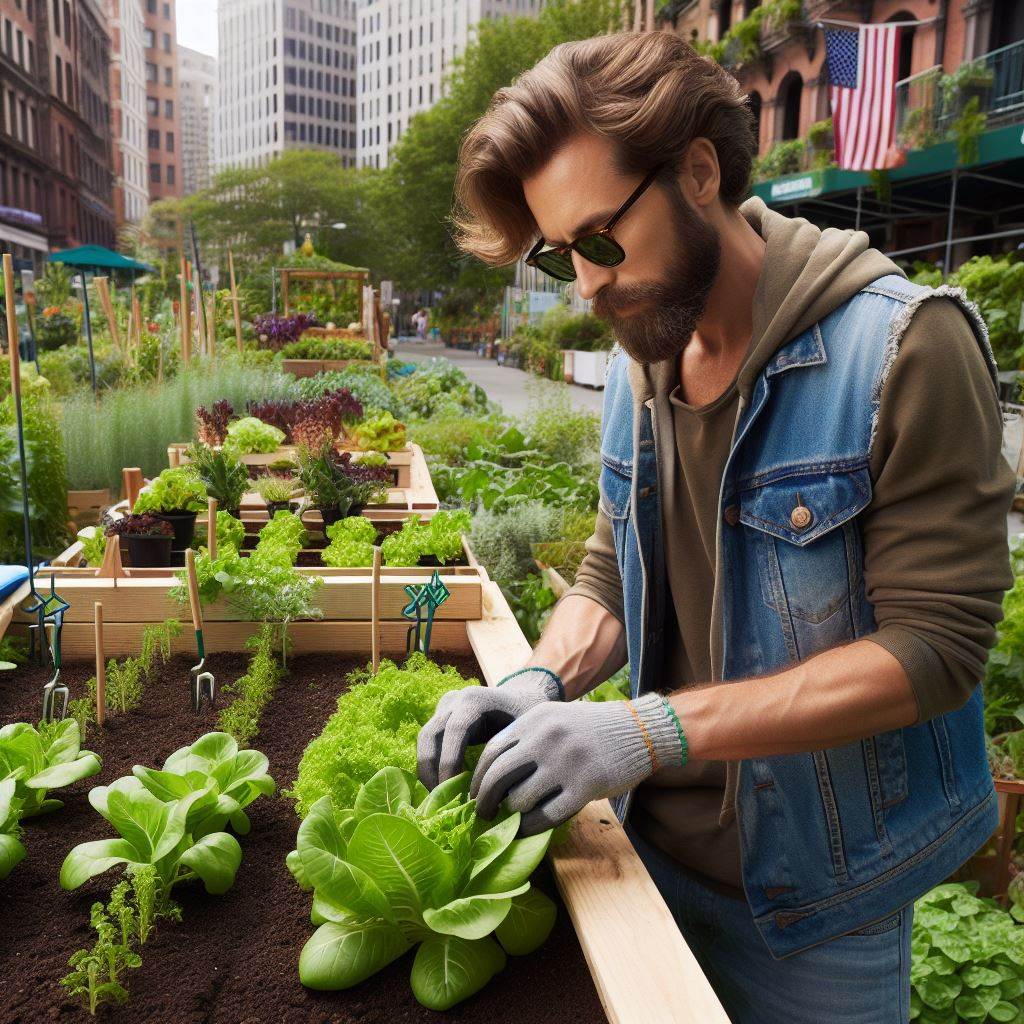Introduction
In the realm of hobbyist horticulture, where passion meets the soil, the concept of seasonal planting emerges as a dynamic and rewarding art form.
As we embark on this botanical journey, we delve into the intricacies of harnessing the power of each season to elevate the beauty and productivity of your garden.
The canvas is not just soil; it’s a living, breathing masterpiece awaiting the touch of a seasoned gardener.
Seasonal planting is more than a science; it’s an orchestration of nature’s symphony.
The objective of this blog post is to provide useful tips and techniques for hobbyist gardeners.
This exploration is a guide for hobbyists, revealing the secrets of selecting, sowing, and nurturing plants in harmony with the changing seasons.
From the rejuvenating bloom of spring to the resilient foliage of winter, understanding the nuances of each season is the key to transforming your garden into a vibrant tapestry of colors, scents, and textures.
Join us in this odyssey through the seasons, where we unlock the secrets of successful hobbyist horticulture.
From strategic planning to hands-on tips, this journey aims to inspire and empower you to curate a garden that evolves with the rhythm of nature.
Welcome to the world of seasonal planting, where your garden becomes a living testament to the artistry and joy of cultivating life from the earth.
Understanding Seasonal Planting
Define seasonal planting and its significance for hobbyists
Seasonal planting refers to the practice of strategically planting different crops or flowers according to the specific seasons.
It is essential for hobbyists as it ensures optimum growth and success in their gardening endeavors.
By aligning planting activities with the seasons, hobbyists can take advantage of the natural conditions and maximize the chances of a bountiful harvest or a vibrant garden.
The benefits of planning planting activities according to the seasons
- Increased success rate: When hobbyists plan their planting activities based on the seasons, they are more likely to have successful outcomes. Different plants thrive in different seasons, and knowing when to sow seeds or transplant seedlings improves their chances of survival.
- Efficient resource utilization: By aligning planting activities with the seasons, hobbyists make better use of available resources such as water, soil nutrients, and sunlight. Plants require varying amounts of these resources at different stages of their growth, and planning accordingly helps prevent waste and ensures efficient utilization.
- Pest and disease management: Planning planting activities according to the seasons allows hobbyists to anticipate and manage common pests and diseases effectively. Certain pests are more active during specific seasons, and by taking preventive measures, hobbyists can safeguard their plants and reduce the risk of pest infestations.
- Continuous harvest and blooms: Seasonal planting enables hobbyists to have a continuous harvest or vibrant blooms throughout the year. By strategically selecting plants that thrive in different seasons, hobbyists can ensure a continuous supply of fresh produce or a visually appealing garden all year round.
The role of climate, temperature, and daylight in seasonal planting
- Climate: Different regions have distinct climate types, such as tropical, temperate, or arid. Understanding the local climate is crucial for successful seasonal planting.
Certain plants are adapted to specific climate conditions, and hobbyists should choose plant varieties that can withstand the prevailing climate in their area. - Temperature: Temperature fluctuations significantly affect plant growth and development.
Some plants thrive in cooler temperatures, while others prefer warmer conditions. Hobbyists need to align their planting activities with the temperature requirements of their chosen plants to ensure optimal growth. - Daylight: Day length, or the amount of sunlight received each day, also plays a significant role in seasonal planting.
Plants that require full sunlight need to be planted during seasons with longer daylight hours. Conversely, shade-tolerant plants are better suited for seasons with shorter days.
In fact, seasonal planting is a vital consideration for hobbyists as it helps maximize success rates, resource utilization, pest management, and continuous harvest or vibrant blooms.
The role of climate, temperature, and daylight cannot be underestimated in the planning and execution of seasonal planting activities.
Transform Your Agribusiness
Unlock your farm's potential with expert advice tailored to your needs. Get actionable steps that drive real results.
Get StartedBy embracing seasonal planting strategies, hobbyists can create thriving gardens and enjoy the fruits of their labor throughout the year.
Spring Planting Strategies
Advantages of starting planting efforts in the spring
- Longer growing season: Spring allows for a longer period of growth and development for plants.
- Favorable weather conditions: Spring offers mild temperatures and more sunlight, promoting healthy plant growth.
- Abundance of resources: Springtime provides ample rainfall, which aids in plant establishment and hydration.
Suitable crops and plants for spring planting
- Leafy greens: Spinach, lettuce, and kale thrive in the cool spring temperatures.
- Root vegetables: Carrots, radishes, and beets can be planted early in the spring for a harvest later on.
- Herbs: Herbs like parsley, basil, and dill can be grown in pots or garden beds during spring.
Tips on soil preparation, seed selection, and sowing techniques for spring
- Soil preparation: Clear any debris, loosen the soil, and mix in compost or organic matter to enhance fertility.
- Seed selection: Choose varieties that are suitable for early planting and check for any special requirements.
- Sowing techniques: Follow the seed packet instructions for depth, spacing, and watering requirements.
- Start indoors: Certain plants like tomatoes and peppers benefit from starting indoors before transplanting outside.
Potential challenges and how to overcome them during spring planting
- Frost: Protect plants from late frosts by covering them with cloths or using frost blankets.
- Pests and diseases: Monitor plants closely for signs of pests or diseases and take appropriate measures such as using organic pest control methods.
- Overwatering: Ensure proper drainage and avoid overwatering, which can lead to root rot or other issues.
- Competition with weeds: Stay vigilant and regularly remove weeds to prevent them from competing with your plants for nutrients.
- Extreme heat: Provide shade or use shade cloths during hot spells to protect delicate plants from sunburn.
In essence, spring is an excellent time for hobbyists to begin their planting efforts.
With a longer growing season, favorable weather conditions, and an abundance of resources, plants can thrive during this season.
Hobbyists can focus on growing suitable crops such as leafy greens, root vegetables, and herbs.
To ensure successful growth, proper soil preparation, seed selection, and sowing techniques are crucial.
Possible challenges during spring planting include frost, pests, overwatering, weed competition, and extreme heat.
By taking necessary precautions and following these strategies, hobbyists can overcome these challenges and enjoy a successful spring planting season.
Read: Composting: A Guide for Urban Farmers
Summer Planting Strategies
Unique Considerations for Planting in the Summer
- Summer planting requires specific precautions due to the intense heat and longer days.
- Soil moisture management becomes crucial as evaporation rates are higher in the summer.
- Sun exposure and heat stress can negatively impact plant growth and development.
Selection of Heat-Tolerant Crops and Plants
- Opt for heat-tolerant crops such as tomatoes, peppers, eggplants, okra, and sweet potatoes.
- Choose plants that thrive in full sun, like marigolds, zinnias, sunflowers, and portulaca.
- Consider planting drought-tolerant varieties, such as succulents and cacti, to conserve water.
Tips for Watering, Pest Management, and Plant Health
- Water plants deeply but less frequently to encourage deep root development.
- Use mulch to retain moisture, suppress weeds, and regulate soil temperature.
- Install drip irrigation systems or soaker hoses to deliver water directly to the plant roots.
- Regularly inspect plants for pests and diseases and take appropriate measures for prevention and control.
- Provide proper nutrition through fertilizers to support plant growth and overall health.
Mitigating Potential Challenges during Summer Planting
- Protect plants from extreme heat by providing shade through shade cloths or pergolas.
- Use row covers or insect netting to prevent pest damage while allowing air circulation.
- Monitor and control weeds in the garden beds to reduce competition for water and nutrients.
- Adjust planting schedule to avoid the peak heat hours and maximize plant’s chances of survival.
- Be vigilant about plant care and maintenance, including regular pruning, to promote optimum growth.
By following these strategies, hobbyists can have a successful summer planting experience with thriving plants and bountiful harvests.
Enjoy your summer gardening!
Read: Balcony Gardens: Growing in Small Spaces

Fall Planting Strategies
Advantages of Fall Planting for Hobbyists
- Fall planting allows hobbyists to extend their growing season and enjoy fresh produce for longer.
- Cooler temperatures in fall provide more comfortable working conditions for hobbyists in the garden.
- Fall planting also helps control pests and diseases, reducing the need for chemical interventions.
- Hobbyists can take advantage of end-of-season sales and discounts on plants and gardening supplies.
Suitable Crops and Plants for Fall Planting
While not all plants thrive in the fall, there are several crops that excel in cooler conditions:
- Leafy greens like lettuce, spinach, and kale can be sown in late summer and harvested well into winter.
- Root vegetables such as carrots, beets, and radishes can be planted in fall for a late-season harvest.
- Cabbage, broccoli, and cauliflower also do well when planted in the fall months.
- Perennial herbs like thyme, sage, and rosemary can be established in the fall for future harvests.
Tips for Soil Preparation, Seed Selection, and Sowing Techniques for Fall
Proper soil preparation is essential to ensure successful fall planting:
- Clear the garden bed of any weeds or debris and amend the soil with compost or organic matter.
- Choose seeds specifically suited for fall planting and ensure they are fresh and viable.
- Follow the recommended sowing depth and spacing instructions provided on the seed packets.
- Water the newly sown seeds gently but regularly to keep the soil consistently moist.
Potential Challenges and How to Address Them for Fall Planting
While fall planting has numerous benefits, hobbyists may encounter some challenges:
- Frost: Protect plants from early frost by using row covers or cold frames to extend the growing season.
- Less sunlight: Monitor the amount of sunlight your garden receives as the days get shorter and consider using artificial lights.
- Heavy rain: Ensure proper drainage to prevent waterlogged soil and potential root rot.
- Pest control: Regularly inspect plants for pests and consider using organic pest control methods before resorting to chemicals.
Fall planting can provide hobbyists with an extended and enjoyable gardening experience.
By taking advantage of the benefits, selecting suitable crops, properly preparing the soil, and addressing potential challenges, hobbyists can have a successful and bountiful fall harvest.
Read: Soil Health: Tips for Small-Scale Farmers
Winter Planting Strategies
Unique Considerations and Limitations for Winter Planting
- Winter weather conditions can pose challenges such as freezing temperatures and reduced sunlight.
- Soil moisture management becomes crucial to prevent waterlogging or dehydration of plants.
- Frost protection methods, like using covers or mulching, are essential to safeguard plants.
Crops and Plants for Indoor or Protected Environment Growing
- Leafy greens like spinach, lettuce, and kale are suitable for indoor cultivation during winter.
- Herbs such as parsley, mint, and thyme can thrive in containers placed near windows for adequate sunlight.
- Microgreens, like radish, broccoli, or sunflower sprouts, can be grown in trays or pots indoors.
- Root vegetables like carrots, beets, and radishes can be planted in pots with proper soil depth.
Tips for Indoor Gardening Techniques, Temperature Control, and Lighting
- Use well-draining soil mixes to ensure proper water retention and prevent root rot.
- Provide sufficient natural light by placing plants near south-facing windows or using grow lights.
- Maintain a temperature range between 65-75°F (18-24°C) during the day and slightly cooler at night.
- Consider using a humidifier to increase moisture levels, as indoor environments may become excessively dry.
Overcoming Challenges in Winter Planting
- Monitor and adjust indoor temperatures regularly to ensure plants are not exposed to extreme cold or heat.
- Control pests by regularly inspecting plants and using organic insecticides or natural predators.
- Prevent diseases by avoiding over-watering, promoting good air circulation, and maintaining cleanliness.
- Boost pollination indoors by gently shaking flowers or using a small brush to transfer pollen between flowers.
- Be patient with slower growth rates and adjust watering and fertilization accordingly.
Winter planting may require additional effort and attention compared to other seasons, but it offers hobbyists the opportunity to continue their gardening pursuits.
By understanding the unique considerations and limitations, choosing suitable crops for indoor cultivation, implementing proper techniques for temperature control and lighting, and overcoming challenges that may arise, hobbyists can enjoy a thriving winter garden.
Read: Hydroponics: Future of Urban Farming?
Planning for Year-Round Planting
The importance of planning for continuous planting throughout the year
- Continuous planting ensures a consistent supply of fresh produce for hobbyist gardeners.
- By planning for year-round planting, hobbyists can maximize their garden’s potential and productivity.
- It helps hobbyists stay engaged in gardening and allows them to enjoy the fruits of their labor all year.
- Planning for continuous planting reduces the risk of a dormant garden during certain seasons.
- It provides a sense of accomplishment and fulfillment as hobbyists witness their plants grow and yield throughout the year.
Strategies for succession planting and crop rotation
- Succession planting involves planting new crops as soon as the previous ones are harvested.
- It allows hobbyists to have a constant supply of their favorite crops without interruption.
- Planting a variety of crops in succession ensures a diverse and sustainable garden ecosystem.
- Crop rotation helps prevent the buildup of pests and diseases by changing the planting location.
- It ensures the long-term health and productivity of the garden by reducing soil depletion.
Tips on maintaining a gardening calendar and tracking planting activities
- Create a gardening calendar by mapping out the entire year, including the specific planting and harvesting dates.
- List the plants you want to grow, their preferred planting times, and their maturity period.
- Use a digital or physical calendar to mark important dates, including fertilization and pest control treatments.
- Regularly update the gardening calendar to record observations and track the progress of each plant.
- Stay organized by grouping plants with similar needs together and planning their watering and maintenance routines accordingly.
Resources for hobbyists to learn more about year-round planting
- Online gardening forums and communities provide a wealth of information and support from experienced hobbyists.
- Join local gardening associations or clubs to connect with like-minded individuals and gain valuable insights.
- Books and magazines focused on year-round planting offer in-depth knowledge and practical tips.
- Attend gardening workshops and seminars to learn from experts and gain hands-on experience.
- Consult with local nurseries and agricultural extension offices for advice tailored to your specific region.
In review, planning for year-round planting is essential for hobbyist gardeners.
By emphasizing the importance of continuous planting, discussing strategies like succession planting and crop rotation, providing tips on maintaining a gardening calendar, and suggesting additional resources, hobbyists can ensure a productive and fulfilling gardening experience throughout the year.
Conclusion
This blog post discussed the importance of seasonal planting strategies for hobbyists.
In exploring seasonal planting for hobbyists, we’ve uncovered the key to year-round gardening success.
Showcase Your Farming Business
Publish your professional farming services profile on our blog for a one-time fee of $200 and reach a dedicated audience of farmers and agribusiness owners.
Publish Your ProfileFrom tailored plant selection to strategic timing, our journey emphasized optimizing each season’s unique characteristics.
By following these strategies, hobbyists can maximize their gardening success and enjoyment.
Seasonal planting isn’t merely a gardening tactic—it’s a game-changer for hobbyists.
Adapting to nature’s rhythm ensures thriving gardens, vibrant blooms, and bountiful harvests, fulfilling every gardening aspiration.
I encourage readers to implement the tips provided and experiment with different planting techniques to enhance their gardening experience.
Now, seize the trowel and implement our tips. Embrace the joy of experimenting with diverse planting techniques.
Your garden is a canvas—paint it with the colors of seasonal abundance.
Happy gardening!




